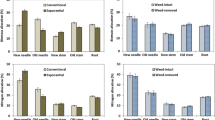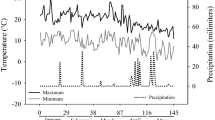Abstract
The effects of different fertilization regimes on root growth characteristics, nutrient uptake and biomass production of Japanese larch (Larix kampferi Sarg.) and its hybrid larch (L. gmelinii × L. kampferi) seedlings were examined for one growing season. Seedlings were raised in the greenhouse under three fertilizer levels (10, 20, 40 mg N seedling−1 season−1) and two delivery schedules, conventional (C) and exponential (E) for 12 weeks. Root growth, biomass allocation and nutrient loading capacity of seedlings were measured for a 3-week interval. By the end of growing season, seedlings fertilized with low dose conventionally (10C) and exponentially (10E) developed relatively longer root and larger root surface areas than those fertilized at high dose exponential loading (40E). At final harvest, the 40E treated Japanese larch had 134% and 155% more shoot mass as compared with those raised under 20E and 10E treated seedlings, respectively. The seedlings fertilized under 10C and 10E showed a high root mass ratio, while 40E treated seedlings showed a low root mass ratio. These data indicated that different nutrient levels (10 mg, 20 mg and 40 mg) strongly affected root growth characteristics. The same seasonal dose (10 mg) applied exponentially (10E) accumulated more N in seedlings compared to the 10C treatment. Exponential fertilization enhanced an increase in N concentration of the whole plant suggesting exponential delivery schedule is an efficient fertilization technique for greater nutrient uptake of plants. In contrast, N concentration of whole plant was declined for seedlings treated with conventional fertilization due to growth dilution. Late in the growing season, seedlings raised under 40E did not significantly improved dry mass production of root, but nutrient accumulation increased without a concomitant increased in root dry mass production. The result suggests that seedlings fertilized exponentially at medium and high dose rates (20E and 40E) induced luxury nutrient consumption within the plant.
Similar content being viewed by others
References
Brouwer R 1962 Nutritive influences on the distribution of dry matter in the plant. Neth. J. Agric. Sci. 10, 399-408.
Brouwer R 1983 Functional equilibrium: sense or nonsense? Neth. J. Agric. Sci. 31, 335-348.
Chapin F S III, Schulze E D and Mooney H A 1990 The ecology and economics of storage in plants. Annu. Rev. Ecol. Syst. 21, 423-447.
Fitter A H 1999 Root as dynamic systems. In The Developmental Ecology of Root and Root Systems. Ed. M C Press and Scholes J D pp. 115-132. Blackwell Science Ltd, UK.
Fitter A H and Stickland T R 1991 Architectural analysis of plant root systems II. Influence of nutrient supply on architecture in contrasting plant species. New Phytol. 118, 383-389.
Fitter A H, Graves J D, Self G K, Brown T K, Bogle D S and Taylor K 1998 Root production, turnover and respiration under two grassland types along an altitude gradient: Influence of temperature and solar radian. Oecologia 114, 20-30.
Fransen B, de Kroon and Berndse H 1998 Root morphological plasticity and nutrient acquisition by perennial grass species from habitats of different nutrient available. Oecologia 115, 351-358.
Gower S T and Rechards J H 1990 Larches: Deciduous conifers in an evergreen world. BioScience 40, 818-826.
Hawkins B J, Henry G and Kiiskila S B R 1998 Biomass and nutrient allocation in Douglas-fir and Amabilis fir seedlings: influence of growth rate and nutrition. Tree Physiol. 18, 803-810.
Imo M and TimmerV R 1992 Nitrogen uptake of mesquite seedlings at conventional and exponential fertilization schedules. Soil Dci. Soc. Am. J. 56, 927-934.
Ingestad T and Lund A B 1979 Nitrogen stress in birth seedlings: Growth technique and growth. Physiol. Plant. 45, 137-148.
Ingestad T and Lund A 1986 Theory and techniques for steady-state mineral nutrition and growth of plants. Scand. J. For. Res. 1, 439-453.
Koike T, Yazaki K, Funada R, Maruyama R, Mori Y and Sasa K 2000 Forest health and vitality in northern Japan-A history of larch plantation. Res. Note, Fac. Forestry, Univ. of Joensuu, 92, 49-60.
Lambers H, Chapin F S III and Pons T L 1998 Plant physiological ecology. pp. 239-263. Springer-Verlag, New York, USA
Litter R C, Henry P R and Ammerman C B 1998 Statistical analysis of repeated measures data using SAS procedures. J. Anim. Sci. 76, 1216-1231.
Malik V and Timmer V R 1995 Interaction of nutrient loaded black spurs seedlings with neighboring vegetation in greenhouse environments. Can. J. For. Res. 25, 1017-1023.
Miller B D and Timmer V R 1994 Steady-state nutrition of Pinus resonosa seedlings: response to nutrient loading, irrigation and hardening regimes. Tree Physiol. 14, 1327-1338.
Munson A D and Bernier P Y 1993 Comparing natural and planted spruce seedlings. II. Nutrient uptake and efficiency of use. Can. J. For. Res. 23, 2435-2442.
Quoreshi A M and Timmer V R 1998 Exponential fertilization increases nutrient uptake and ectomycorrhizal development of black spruce seedlings. Can. J. For. Res. 28, 674-682.
Quoreshi A M and Timmer V R 2000 Growth, nutrient dynamics, and ectomycorrhizal development of container-grown Picea mariana seedlings in response to exponential nutrient loading. Can. J. For. Res. 30, 191-201.
SAS Institute Inc. 1996 SAS/STAT user's guide. SAS Institute Inc., Cary, N.C.
Taub D B and Goldberg D 1996 Root system topology of plants from habitats differing in soil resource availability. Funct. Ecol. 10, 258-264.
Timmer V R 1997 Exponential nutrient loading: A new fertilization technique to improve seedlings performance on competitive sites. New Forest 13, 279-299.
Timmer V R and Armstrong G 1987 Growth and nutrition of Pinus resinosa seedlings at exponential increasing nutrient additions. Can. J. For. Res. 17, 644-647.
Timmer V R and Munson A D 1991 Site-specific growth and nutrient uptake of planted Picea mariana in the Ontario Clay Belt. IV. Nitrogen loading response. Can. J. For. Res. 21, 1058-1065.
Xu X J and Timmer V R 1998 Biomass and nutrient dynamics of Chinese fir seedlings under conventional and exponential fertilization regimes. Plant Soil 203, 313-322.
Author information
Authors and Affiliations
Corresponding author
Rights and permissions
About this article
Cite this article
Qu, L., Quoreshi, A.M. & Koike, T. Root growth characteristics, biomass and nutrient dynamics of seedlings of two larch species raised under different fertilization regimes. Plant and Soil 255, 293–302 (2003). https://doi.org/10.1023/A:1026159709246
Issue Date:
DOI: https://doi.org/10.1023/A:1026159709246




